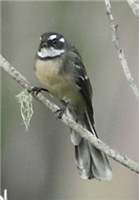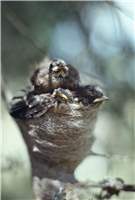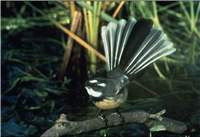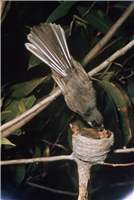Family
Dicruridae
Genus
Rhipidura
Species
fuliginosa
Threats/Control Methods - Regional
Many woodland species are threatened by land clearing, as woodlands are poorly represented in reserves and remaining vegetation is often very fragmented and continually at risk of further small-scale clearing. This species will also decline if processes that lead to habitat simplification like grazing continue.
Threats/Control Methods - Local
Within the suburbs, domestic Cats (Felis catus) are known for attempting to hunt this species.
Local/Urban Actions
The preservation of large areas of suitable woodland habitat is key to the survival of this species. This is facilitated through local Landcare groups or Greening Australia. Gardeners can encourage the species by ensuring their yard consists of a good mix of trees, shrubs and ground litter. Cat owners can prevent their pets preying on the species by providing a stimulating indoor environment and by installing a cat run or enclosure.
Common Names
Grey Fantail, White-shafted Fantail, Cranky Fan, Fanny, Mad Fan
Distinguishing Features
The Grey Fantail's twisting in-flight acrobatics and constantly fanned tail make the species one of the best known in Australian gardens. It is a small bird 14-17cm in size with distinctively long tail feathers. It has a mostly grey plumage with white eyebrows, earmark, throat and two narrow wing bars.
Survey Techniques
Call and visual identification.
Species Call
A variety of rich, tinkling whistles, or a repeated 'check' note.
Similar Species
Willie Wagtail (Rhipidura leucophrys ) is very similar but slightly larger, while the Rufous Fantail (Rhipidura rufifrons) has distinctive rusty red colouring on its back and brow.
Distribution
The Grey Fantail is found right across Australia.
Country of Origin
Australia.
Conservation (Pet/Pest) Status - Regional
Abundance has steadily increased since 1981 (COG). It is considered the second most commonly recorded breeding species.
Conservation (Pet/Pest) Status - National
Secure, not listed under the EPBC Act 1999. The population of Norfolk Island (Rhipidura fuliginosa pelzelni) is considered vulnerable due to the small area it occupies.
LSCCES Population
The Grey Fantail was found in very high numbers at CSIRO and BMt, while none were recorded at NMA, Turner or Civic West.
Associated vegetation community
All woodland and forest areas make suitable habitats for the species.
Limiting Resources
Heavily urbanised areas are not suitable habitats, as the species needs plenty of vegetation layers, including trees, thick shrubs, logs and ground cover. Vegetation cannot be fragmented.
Breeding
The Grey Fantail builds its nest in a thin tree-fork, unusually between 2 and 5 metres from the ground. It is made of fine grass bound together with large amounts of spider web. Both parents share nest-building, 14 day incubation of their 2-3 eggs and feeding of the young over the 12 days in the nest. In Canberra, dependant young are noticed from January to early March.
Behaviour
This species is very confident around humans, happily fluttering around with a chirpy voice.
Functional Group
Food Species
The Grey Fantail feeds on any insects found around the foliage of trees or large shrubs.
Predators
The confidence of the Grey Fantail around human settlements makes the species prone to predation from pets, especially Cats (Felis catus).
Interesting Fact
There are five different races of Grey Fantail across Australia, all a different shade of grey.
References - (reader suitability of references, P=Primary teachers, S=Secondary students, T=Tertiary students and researchers)
Books:
Freudenberger, D. 2001. Bush for the birds: Biodiversity enhancement guidelines for the Saltshaker Project, Boorowa, NSW. Consultancy report to Greening Australia ACT and SE NSW Inc. CSIRO Sustainable Ecosystems. Canberra. S, T
Morcombe, M. 2000. Field Guide to Australian Birds. Steve Parish Publishing. Archerfield. Australia P, S, T
Schodde, R. and Tideman, S. (eds) 1990. Reader's Digest Complete Book of Australian Birds (2nd Edition). Reader's Digest Services Pty Ltd. Sydney. P, S, T
Simpson and Day. 1993. Field Guide to the Birds of Australia. Forth Ed. Penguin Books. Victoria. Australia P, S, T
Veerman, P. 2003. Canberra Birds: A report on the first 21 years of the garden bird survey. Philip Veerman and Canberra Ornithologists Group. Canberra. S, T
Internet:
Birds in Backyards. 2006. [online]. Available at:
http://www.birdsinbackyards.net P, S, T
Canberra Ornithological Group (COG). 2004. Birds of Canberra Gardens. COG and the ACT Department of Urban Services. [online]. Available at
http://garden.canberrabirds.org.au/ P, S, T
Online Publications:
Garnett, S. and Crowley, M. 2000. The Action Plan for Australian Birds 2000. Department of Environment and Water Resources. [online]. Available at http://www.deh.gov.au/biodiversity/threatened/publications/action/birds2000/index.html S, T
Nix, H. and Cunningham, R. 2006. Birds of the Lower Sullivans Creek Catchment, Canberra ACT. Prepared for the Life in the Suburbs project using data from the Lower Sullivans Creek Catchment Ecological Survey (LSCCES). Australian National University. Canberra. [online]. Available at http://www.lifeinthesuburbs.com.au/category.php?id=65 S, T
Olsen, P. et al. 2005. The State of Australia's Birds 2005: Woodlands and Birds. Supplement to Wingspan 15:4. Birds Australia. [online]. Available at http://www.birdsaustralia.com.au/soab/SOAB2005.pdf S, T
Taws, N. et al. 2001. Bringing Birds Back: A Glovebox Guide for Bird Identification and Habitat Restoration in ACT and SE NSW. Greening Australia ACT and SE NSW Inc. [online]. Available at: http://www.greeningaustralia.org.au/NR/rdonlyres/D8B0DB48-7B51-419D-9C93-A48FB26E8CD3/3888/G12446BBBreprint1.pdf P, S, T




 Top
Top Top
Top